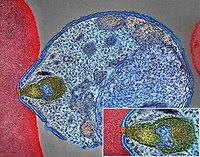
Photo from wikipedia
Abstract Surveillance data shows a geographical overlap between the early coronavirus disease 2019 (COVID-19) pandemic and the past Q fever epidemic (2007–2010) in the Netherlands. We investigated the relationship between… Click to show full abstract
Abstract Surveillance data shows a geographical overlap between the early coronavirus disease 2019 (COVID-19) pandemic and the past Q fever epidemic (2007–2010) in the Netherlands. We investigated the relationship between past Q fever and severe acute respiratory syndrome coronavirus 2 (SARS-CoV-2) infection in 2020/2021, using a retrospective matched cohort study. In January 2021, former Q fever patients received a questionnaire on demographics, SARS-CoV-2 test results and related hospital/intensive care unit (ICU) admissions. SARS-CoV-2 incidence with 95% confidence intervals (CI) in former Q fever patients and standardised incidence ratios (SIR) to compare to the age-standardised SARS-CoV-2 incidence in the general regional population were calculated. Among 890 former Q fever patients (response rate: 68%), 66 had a PCR-confirmed SARS-CoV-2 infection. Of these, nine (14%) were hospitalised and two (3%) were admitted to ICU. From February to June 2020 the SARS-CoV-2 incidence was 1573/100 000 (95% CI 749–2397) in former Q fever patients and 695/100 000 in the general population (SIR 2.26; 95% CI 1.24–3.80). The incidence was not significantly higher from September 2020 to February 2021. We found no sufficient evidence for a difference in SARS-CoV-2 incidence or an increased severity in former Q fever patients vs. the general population during the period with widespread SARS-CoV-2 testing availability (September 2020–February 2021). This indicates that former Q fever patients do not have a higher risk of SARS-CoV-2 infection.
Journal Title: Epidemiology and Infection
Year Published: 2022
Link to full text (if available)
Share on Social Media: Sign Up to like & get
recommendations!